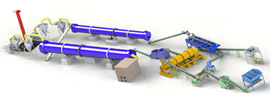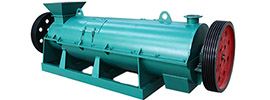The organic fertilizer disc pelletizer is a device that achieves granulation through the combined effects of disc rotation and material properties. It is suitable for pelletizing organic wastes such as livestock manure, straw, and sludge, utilizing both physical mechanics and chemical interactions. Below are the core steps and principles of its granulation process:
I. Granulation Principles
-
Synergistic Action of Centrifugal and Frictional Forces
The disc rotates at an inclined angle (typically 40°–55°), causing materials to move toward the edge under centrifugal force while friction against the disc base and sidewall forms a rolling layer.
-
Layer-by-Layer Particle Growth
Fine particles adhere to each other to form seed nuclei, which gradually grow by absorbing surrounding powder and liquid (e.g., binders or moisture) through layer-by-layer coating until reaching the target size.
-
Automatic Grading and Discharge
Qualified pellets overflow from the disc edge due to gravity, while undersized particles remain for further growth and oversized ones are crushed and recycled.
II. Granulation Process Flow
- Raw Material Pretreatment
- Crushing: Organic waste (e.g., manure, straw) is ground to 20–60 mesh for uniformity.
- Blending: Auxiliary materials (e.g., bentonite, humic acid) and binders (e.g., starch, polyacrylamide) are added in proportion, adjusting moisture content to 30%–40%.
- Fermentation (optional): Composting kills pathogens and enhances organic matter content.
- Feeding and Moistening
- Materials are uniformly fed into the disc center via belt or screw conveyors.
- A spray system simultaneously applies water or binders to ensure proper wetness without clumping.
- Disc Granulation
- Disc Activation: Adjust rotational speed (10–20 rpm) and inclination angle to stabilize the rolling layer.
- Particle Formation: Seed nuclei grow by adsorbing powder through physical compaction and chemical bonding, forming dense pellets.
- Size Control: Particle diameter (2–6 mm) is regulated by adjusting speed, angle, and retention time (5–15 minutes).
- Drying and Screening
- Drying: Pellets are dried via hot air or natural sunning to reduce moisture to 15%–20%, improving hardness.
- Screening: A vibrating sieve separates qualified pellets; non-conforming ones are returned for reprocessing.
III. Key Parameter Optimization
- Disc Specifications
- Diameter: Selected based on output (e.g., 2 m, 2.4 m, 3 m); larger discs increase capacity.
- Rotational Speed: Too low slows growth; too high causes breakage. Optimal values are determined experimentally.
- Inclination Angle: Excessively small angles cause material accumulation; overly steep angles accelerate discharge. Typically maintained at 45° ±5°.
- Material Properties
- Moisture Content: Excessive moisture causes sticking; insufficient moisture hinders bonding. Pre-testing is required.
- Binder Dosage: Insufficient binders result in fragile pellets; excessive use increases costs and may affect fertilizer efficacy.
- Environmental Control
- Temperature: Preheat materials in winter to prevent binder failure due to low temperatures.
- Humidity: High workshop humidity may cause material absorption and clumping; ensure ventilation and dryness.
IV. Equipment Advantages and Applications
- Advantages:
- Simple structure, easy operation/maintenance, suitable for small-to-medium-scale production.
- High particle uniformity with a pelletizing rate of 70%–90%.
- Flexible parameter adjustments for producing pellets of varying sizes.
- Applications:
- Pelletizing livestock manure, straw, sludge, and other organic wastes.
- Manufacturing bio-organic and compound fertilizers.
- Scenarios requiring rapid startup and adjustable output.
V. Common Issues and Solutions
- Fragile/Loose Pellets
- Cause: Insufficient binder or low moisture.
- Solution: Increase binder dosage or adjust humidity.
- Disc Material Adhesion
- Cause: Excessive moisture or rough disc surface.
- Solution: Reduce moisture or polish the disc.
- Uneven Particle Sizes
- Cause: Uneven feeding or speed fluctuations.
- Solution: Optimize feeding systems and install frequency converters for stable speed.
By controlling process parameters and equipment operation effectively, disc pelletizers can efficiently produce high-quality organic fertilizer pellets, providing reliable technical support for agricultural waste resource utilization.
This translation preserves the original text's technical depth while ensuring clarity and fluency for an English-speaking audience in the agricultural or engineering sectors.
 Send us a Email
Send us a Email Wulong Industrial Cluster
Wulong Industrial Cluster Have any question?
Have any question?



















